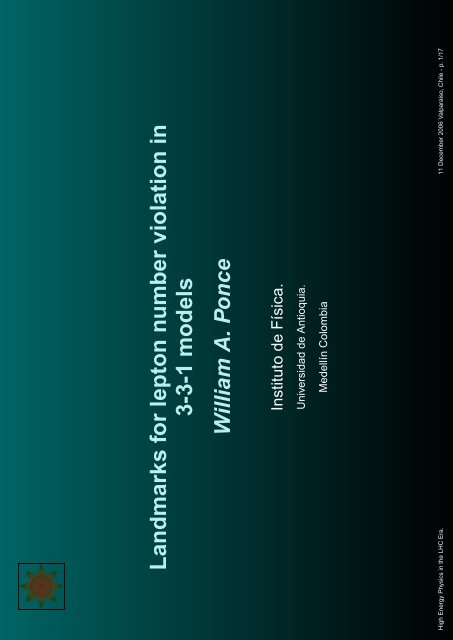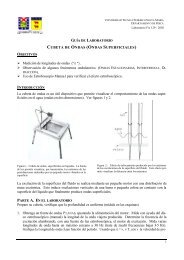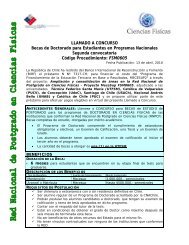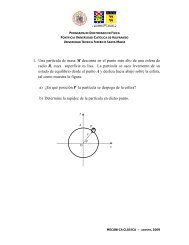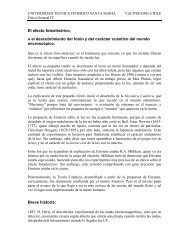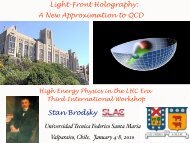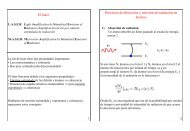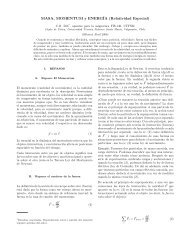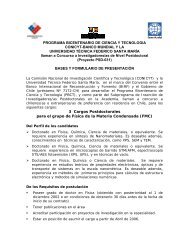Leptons - Departamento de Física
Leptons - Departamento de Física
Leptons - Departamento de Física
You also want an ePaper? Increase the reach of your titles
YUMPU automatically turns print PDFs into web optimized ePapers that Google loves.
Landmarks for lepton number violation in3-3-1 mo<strong>de</strong>lsWilliam A. PonceInstituto <strong>de</strong> <strong>Física</strong>.Universidad <strong>de</strong> Antioquia.Me<strong>de</strong>llín ColombiaHigh Energy Physics in the LHC Era. 11 December 2006 Valparaiso, Chile - p. 1/17
3-3-1➲ 3-3-1➲ Electric Charge Operator➲ Pisano-Pleitez-FramptonMo<strong>de</strong>l b=3/2➲ The scalar sector➲ Lepton Number violation 1➲ Lepton Number violation 2➲ Mo<strong>de</strong>l with Right-Han<strong>de</strong>dneutrinos b=1/2➲ The scalar sector➲ Lepton Number Violation 1➲ Lepton Number violation 2➲ The economical 3-3-1mo<strong>de</strong>l b=1/2➲ Lepton Number Violation 1➲ Lepton Number Violation 2➲ The Majoron Gauged away➲ Mo<strong>de</strong>l with exotic electronsb=1/2➲ CONCLUSIONSSU(3)c ⊗ SU(3)L ⊗ U(1)X▲ Free of gauge anomalies iff NF multiple of 3 (only 3 ifassimptotic freedom of QCD is imposed).▲ Peccei-Quinn symmetry can be easily implemented.▲ Third quark family different from other two.▲ Scalar sector with good candidates for dark matter.▲ Suitable for explaining some neutrino properties.▲ Strong hierarchy in the Yukawas can be avoi<strong>de</strong>d (byimplementing universal see-saw mechanisms).C-Garcia Canal. H.Fanchiotti, L. EpeleHigh Energy Physics in the LHC Era. 11 December 2006 Valparaiso, Chile - p. 2/17
Electric Charge OperatorQ = λ 3L2+ bλ √ 8L3+ XI3➲ 3-3-1➲ Electric Charge Operator➲ Pisano-Pleitez-FramptonMo<strong>de</strong>l b=3/2➲ The scalar sector➲ Lepton Number violation 1➲ Lepton Number violation 2➲ Mo<strong>de</strong>l with Right-Han<strong>de</strong>dneutrinos b=1/2➲ The scalar sector➲ Lepton Number Violation 1➲ Lepton Number violation 2➲ The economical 3-3-1mo<strong>de</strong>l b=1/2➲ Lepton Number Violation 1➲ Lepton Number Violation 2➲ The Majoron Gauged away➲ Mo<strong>de</strong>l with exotic electronsb=1/2➲ CONCLUSIONSb = 1/2, 3/2, 5/2, . . . n/2▲ b = 1/2 mo<strong>de</strong>ls without exotic electric charges.▲ b = 3/2 the Pisano-Pleitez-Frampton mo<strong>de</strong>l (Minimal).For b = 1/2 there are:▲ 2 one family mo<strong>de</strong>ls reported in the literaure.▲ 4 different mo<strong>de</strong>ls reported in the literature.▲ 4 more three family mo<strong>de</strong>ls.If exotic electric charges are allowed, ∞ number of mo<strong>de</strong>ls.For SU(3)L∑αλαA α µ = √ 2⎛0 + (b+1/2)D 1µ 0 W µ + K µ(b+1/2)W µ − D 2µ 0 K µ(b−1/2)K µ −(b+1/2) K µ −(b−1/2) D 3µ0⎞⎟ ⎠ ,High Energy Physics in the LHC Era. 11 December 2006 Valparaiso, Chile - p. 3/17
Pisano-Pleitez-Frampton Mo<strong>de</strong>l b=3/2➲ 3-3-1➲ Electric Charge Operator➲ Pisano-Pleitez-FramptonMo<strong>de</strong>l b=3/2➲ The scalar sector➲ Lepton Number violation 1➲ Lepton Number violation 2➲ Mo<strong>de</strong>l with Right-Han<strong>de</strong>dneutrinos b=1/2➲ The scalar sector➲ Lepton Number Violation 1➲ Lepton Number violation 2➲ The economical 3-3-1mo<strong>de</strong>l b=1/2➲ Lepton Number Violation 1➲ Lepton Number Violation 2➲ The Majoron Gauged away➲ Mo<strong>de</strong>l with exotic electronsb=1/2➲ CONCLUSIONSQuarks:Q i L = (di , u i , X i )L ∼ (3, 3 ∗ , −1/3), i = 1, 2. Two families.Q 3 L = (u3 , d 3 , Y )L ∼ (3, 3, 2/3). Third family.X i , i = 1, 2 two exotic quarks Q = −4/3.Y an exotic quark. Q = 5/3.Right-Han<strong>de</strong>d quarksu acX icL ∼ (3∗ , 1, −2/3), d acL ∼ (3∗ , 1, 1/3) a = 1, 2, 3,,L ∼ (3∗ , 1, 4/3), i = 1, 2, Y L c ∼ (3∗ , 1, −5/3).<strong>Leptons</strong>LlL = (νl 0 , l− , l + )L ∼ (1, 3, 0), l = e, µ, τ. ν L 0cnot present.F.Pisano,V.Pleitez,Phys.Rev.D50,548(1994);P.Frampton,Phys.Rev.Lett 69,2889(1992)High Energy Physics in the LHC Era. 11 December 2006 Valparaiso, Chile - p. 4/17
The scalar sector➲ 3-3-1➲ Electric Charge Operator➲ Pisano-Pleitez-FramptonMo<strong>de</strong>l b=3/2➲ The scalar sector➲ Lepton Number violation 1➲ Lepton Number violation 2➲ Mo<strong>de</strong>l with Right-Han<strong>de</strong>dneutrinos b=1/2➲ The scalar sector➲ Lepton Number Violation 1➲ Lepton Number violation 2➲ The economical 3-3-1mo<strong>de</strong>l b=1/2➲ Lepton Number Violation 1➲ Lepton Number Violation 2➲ The Majoron Gauged away➲ Mo<strong>de</strong>l with exotic electronsb=1/2➲ CONCLUSIONS(1)〈η1〉 = 〈(η 0 , η − 1 , η+ 2 )〉 = 〈(v 1, 0, 0)〉 ∼ (1, 3, 0)〈ρ〉 = 〈(ρ + , ρ 0 , ρ ++ )〉 = 〈(0, v2, 0)〉 ∼ (1, 3, 1)〈χ〉 = 〈(χ − , χ −− , χ 0 )〉 = 〈(0, 0, V )〉 ∼ (1, 3, −1)S =⎛σ 1 0 s + 1 s − 2⎜ ⎝ s + 1 s ++1 σ 202 2 0 s − σ s −−2⎞⎟ ⎠ ∼ (1, 6 ∗ , 0).〈σ 0 1〉 = v4 and 〈σ 0 2〉 = v ′ 4.High Energy Physics in the LHC Era. 11 December 2006 Valparaiso, Chile - p. 5/17
Lepton Number violation 1➲ 3-3-1➲ Electric Charge Operator➲ Pisano-Pleitez-FramptonMo<strong>de</strong>l b=3/2➲ The scalar sector➲ Lepton Number violation 1➲ Lepton Number violation 2➲ Mo<strong>de</strong>l with Right-Han<strong>de</strong>dneutrinos b=1/2➲ The scalar sector➲ Lepton Number Violation 1➲ Lepton Number violation 2➲ The economical 3-3-1mo<strong>de</strong>l b=1/2➲ Lepton Number Violation 1➲ Lepton Number Violation 2➲ The Majoron Gauged away➲ Mo<strong>de</strong>l with exotic electronsb=1/2➲ CONCLUSIONSLepton number L is not a good Q.NL(l − L , ν lL) = −L(l + L ) = 1, L(u aL, u c aL, daL, d c aL, W ± ) = 0L(K ++ , K + , YL, X c iL) = −2 = −L(K −− , K − , XiL, Y c L)L(χ − , χ −− , s −−2 ) = 2, L(η 2 + , ρ++ , σ 1, 0 s + 1 , s++ 1 ) = −2L(η 0 , η − 1 , χ0 , ρ + , ρ 0 , σ 0 2, s − 2 ) = 0X −4/3i and Y 5/3 are bileptoquarks.K + , K − , K ++ and K −− are bilepton gauge bosons.L = 2λ 8√ + LI3,3High Energy Physics in the LHC Era. 11 December 2006 Valparaiso, Chile - p. 6/17
➲ 3-3-1➲ Electric Charge Operator➲ Pisano-Pleitez-FramptonMo<strong>de</strong>l b=3/2➲ The scalar sector➲ Lepton Number violation 1➲ Lepton Number violation 2➲ Mo<strong>de</strong>l with Right-Han<strong>de</strong>dneutrinos b=1/2➲ The scalar sector➲ Lepton Number Violation 1➲ Lepton Number violation 2➲ The economical 3-3-1mo<strong>de</strong>l b=1/2➲ Lepton Number Violation 1➲ Lepton Number Violation 2➲ The Majoron Gauged away➲ Mo<strong>de</strong>l with exotic electronsb=1/2➲ CONCLUSIONSLepton Number violation 2L(ψlL) = 1/3, L(QiL) = 2/3, L(Q3L, η, S, ρ) = −2/3, L(χ) =4/3, L(X iL c ) = −2, L(Y L c ) = 2, and L(uc a, d c a, Aαµ) = 0.Since L(η 0 , χ 0 , ρ 0 , σ 2) 0 = 0.L number can be spontaneously violated only in 〈σ 1〉.0But it may be explicitly violated in the scalar potential.VLV = f1ηSη+f2SSS+κ1(χ † η)(ρ † η)+κ2η † Sχρ+κ3χρSS+h.c.,Explicitly violates ∆L = ∆L=±2.L number violation :(1) VLV = 0 and 〈S〉 = 0. Total lepton number is conserved.Neutrinos are massles. Ruled out (mν ≠ 0).(2) VLV = 0 but 〈σ 1〉 0 ≠ 0. L is spontaneously broken with tripletMajoron. Ruled out.(3) VLV ≠ 0 and 〈σ 1〉 0 = 0. L is violated explicitly. mν ≠ 0 fromquantum corrections.(4) VLV ≠ 0 and 〈σ 1〉 0 ≠ 0 is also possible. Presence ofpseudo-Goldstone Majorons.High Energy Physics in the LHC Era. 11 December 2006 Valparaiso, Chile - p. 7/17
Mo<strong>de</strong>l with Right-Han<strong>de</strong>d neutrinos b=1/2Quarks:➲ 3-3-1➲ Electric Charge Operator➲ Pisano-Pleitez-FramptonMo<strong>de</strong>l b=3/2➲ The scalar sector➲ Lepton Number violation 1➲ Lepton Number violation 2➲ Mo<strong>de</strong>l with Right-Han<strong>de</strong>dneutrinos b=1/2➲ The scalar sector➲ Lepton Number Violation 1➲ Lepton Number violation 2➲ The economical 3-3-1mo<strong>de</strong>l b=1/2➲ Lepton Number Violation 1➲ Lepton Number Violation 2➲ The Majoron Gauged away➲ Mo<strong>de</strong>l with exotic electronsb=1/2➲ CONCLUSIONSQ i L = (ui , d i , D i )L ∼ (3, 3, 0), i = 1, 2. Two families.Q 3 L = (d3 , u 3 , U)L ∼ (3, 3 ∗ , 1/3). Third family., i = 1, 2 two exotic Down quarks.UL an exotic Up quark.D i LRight-Han<strong>de</strong>d quarksu acL ∼ (3∗ , 1, −2/3), d acL ∼ (3∗ , 1, 1/3)a = 1, 2, 3,D L ic ∼ (3∗ , 1, 1/3), i = 1, 2, U L c ∼ (3∗ , 1, −2/3).<strong>Leptons</strong>LlL = (l − , νl 0 , ν0c l)L ∼ (1, 3 ∗ , −1/3), l = e, µ, τ.Singlets l + L ∼ (1, 1, 1). ν0 lL neutrino related to lepton l− L .the right-han<strong>de</strong>d neutrinos.νlL 0cR.Foot, H.N.Long and T.A.Tran, Phys. Rev. D50, R34 (1994)High Energy Physics in the LHC Era. 11 December 2006 Valparaiso, Chile - p. 8/17
The scalar sector➲ 3-3-1➲ Electric Charge Operator➲ Pisano-Pleitez-FramptonMo<strong>de</strong>l b=3/2➲ The scalar sector➲ Lepton Number violation 1➲ Lepton Number violation 2➲ Mo<strong>de</strong>l with Right-Han<strong>de</strong>dneutrinos b=1/2➲ The scalar sector➲ Lepton Number Violation 1➲ Lepton Number violation 2➲ The economical 3-3-1mo<strong>de</strong>l b=1/2➲ Lepton Number Violation 1➲ Lepton Number Violation 2➲ The Majoron Gauged away➲ Mo<strong>de</strong>l with exotic electronsb=1/2➲ CONCLUSIONSη T = (η 0 1, η − 2 , η0 3) ∼ (1, 3, −1/3),ρ T = (ρ + 1 , ρ0 2, ρ + 3 ) ∼ (1, 3, 2/3),χ T = (χ 0 1, χ − 2 , χ0 3) ∼ (1, 3, −1/3)VEV 〈η 0 1〉 = v1, 〈ρ 0 2〉 = v2 and 〈χ 0 3〉 = v3.Notice 〈η 3〉 0 = 0, 〈χ 0 1〉 = 0 by choice (avoids spontaneouslyLepton number violation).High Energy Physics in the LHC Era. 11 December 2006 Valparaiso, Chile - p. 9/17
Lepton Number Violation 1➲ 3-3-1➲ Electric Charge Operator➲ Pisano-Pleitez-FramptonMo<strong>de</strong>l b=3/2➲ The scalar sector➲ Lepton Number violation 1➲ Lepton Number violation 2➲ Mo<strong>de</strong>l with Right-Han<strong>de</strong>dneutrinos b=1/2➲ The scalar sector➲ Lepton Number Violation 1➲ Lepton Number violation 2➲ The economical 3-3-1mo<strong>de</strong>l b=1/2➲ Lepton Number Violation 1➲ Lepton Number Violation 2➲ The Majoron Gauged away➲ Mo<strong>de</strong>l with exotic electronsb=1/2➲ CONCLUSIONSL is not a good quantum either. νlL 0cantiparticle of νlL 0 .L does not commute with SU(3)L ⊗ U(1)X.L(l − L , ν0 lL ) = −L(l+ L , ν0c lL ) = 1L(uaL, u c aL , d aL, d c aL , W ± , Z, Z ′ ) = 0is i<strong>de</strong>ntified with theL(K + , K 0 , UL, D iL c ) = −2 = −L(K− , K 0 , DiL, U L c ).L(χ − 2 , χ0 1) = 2, L(ρ + 3 , η0 3) = −2L(ρ + 1 , ρ0 2, η 1, 0 η 2 − , χ0 3) = 0.D −1/3i and U 2/3 are bileptoquarks.K + , K − , K 0 and K 0 are bilepton gauge bosons.L = 2λ 8√ + LI3, 3High Energy Physics in the LHC Era. 11 December 2006 Valparaiso, Chile - p. 10/17
Lepton Number violation 2L broken explicitly by:➲ 3-3-1➲ Electric Charge Operator➲ Pisano-Pleitez-FramptonMo<strong>de</strong>l b=3/2➲ The scalar sector➲ Lepton Number violation 1➲ Lepton Number violation 2➲ Mo<strong>de</strong>l with Right-Han<strong>de</strong>dneutrinos b=1/2➲ The scalar sector➲ Lepton Number Violation 1➲ Lepton Number violation 2➲ The economical 3-3-1mo<strong>de</strong>l b=1/2➲ Lepton Number Violation 1➲ Lepton Number Violation 2➲ The Majoron Gauged away➲ Mo<strong>de</strong>l with exotic electronsb=1/2➲ CONCLUSIONS(2)V ′ LV = µχ † η + η † χ(κ1|ρ| 2 + κ2|η| 2 + κ3|χ| 2 )+ κ4|χ † η| 2 + κ5(η † ρ)(ρ † χ) + h.c.,with∆L = ∆L = ±2 when all the VEV are zero.Three cases:(1) V V ′ L = 0, 〈χ0 1〉 = 〈η 3〉 0 = 0. L conserved. νl 0 get only Diracmasses.(2) V V ′ L = 0, 〈χ0 1〉 ≠ 0 and/or 〈η 3〉 0 ≠ 0. L is spontaneouslyviolated. A CP odd Majoron is present.(3) V V ′ L ≠ 0, 〈χ0 1〉 = 〈η 3〉 0 = 0. L explicitly violated. νl 0 massesgenerated by quantum loops.High Energy Physics in the LHC Era. 11 December 2006 Valparaiso, Chile - p. 11/17
The economical 3-3-1 mo<strong>de</strong>l b=1/2➲ 3-3-1➲ Electric Charge Operator➲ Pisano-Pleitez-FramptonMo<strong>de</strong>l b=3/2➲ The scalar sector➲ Lepton Number violation 1➲ Lepton Number violation 2➲ Mo<strong>de</strong>l with Right-Han<strong>de</strong>dneutrinos b=1/2➲ The scalar sector➲ Lepton Number Violation 1➲ Lepton Number violation 2➲ The economical 3-3-1mo<strong>de</strong>l b=1/2➲ Lepton Number Violation 1➲ Lepton Number Violation 2➲ The Majoron Gauged away➲ Mo<strong>de</strong>l with exotic electronsb=1/2➲ CONCLUSIONSχ T = (χ 0 1, χ − 2 , χ0 3) ∼ (1, 3, −1/3) andρ T = (ρ + 1 , ρ0 2, ρ + 3 ) ∼ (1, 3, 2/3) as in the previous mo<strong>de</strong>l.The VEV are 〈χ〉 T = (v1, 0, V ) and 〈ρ〉 T = (0, v, 0)Notice L(χ 0 1) = 2. −→ spontaneous breaking of L.The scalar potentialV (χ, ρ) = µ 2 1|χ| 2 + µ 2 2|ρ| 2 + κ1|χ † χ| 2+ κ2|ρ † ρ| 2 + κ3|χ| 2 |ρ| 2 + κ4|χ † ρ| 2 + h.c..Conserves L and L.W.A.Ponce, Y.Giraldo and L.A.Sanchez, Phys. Rev. D67, 075001 (2003)High Energy Physics in the LHC Era. 11 December 2006 Valparaiso, Chile - p. 12/17
Lepton Number Violation 1The Yukawa Lagrangean: L Y = L Y LNC + LY LNV ,➲ 3-3-1➲ Electric Charge Operator➲ Pisano-Pleitez-FramptonMo<strong>de</strong>l b=3/2➲ The scalar sector➲ Lepton Number violation 1➲ Lepton Number violation 2➲ Mo<strong>de</strong>l with Right-Han<strong>de</strong>dneutrinos b=1/2➲ The scalar sector➲ Lepton Number Violation 1➲ Lepton Number violation 2➲ The economical 3-3-1mo<strong>de</strong>l b=1/2➲ Lepton Number Violation 1➲ Lepton Number Violation 2➲ The Majoron Gauged away➲ Mo<strong>de</strong>l with exotic electronsb=1/2➲ CONCLUSIONSL Y LNC = h U χ ∗ Q3LCU c L + h D ijχQiLCD c jL + h d aρ ∗ Q3LCd c aL+ h u iaρQiLCu c aL + h e ll ′ ρ ∗ ψlLCl ′+ L + h ll ′ρψ lLCψl ′ L + h.c.L Y LNV = h u aχ ∗ Q3LCu c aL + h d iaχQiLCd c aL + h D i ρ ∗ Q3LCD c iLL Y LNV+ h U i ρQiLCU c L + h.c.,violates explicitly L and L by two units.After spontaneous breaking: [χ 0 1 = v1 + (Hχ + iAχ)/ √ 2]VLNV (χ, ρ) = v1[ √ 2Hχ(κ1|χ| 2 +κ3|ρ| 2 )]+v1κ4[ρ − 1 (χ† ρ)+ρ + 1 (ρ† χ)].Notice: VLNV = 0 for v1 = 0.High Energy Physics in the LHC Era. 11 December 2006 Valparaiso, Chile - p. 13/17
Lepton Number Violation 2ρ 0 2 = v + (Hρ + iAρ)/ √ 2, χ 0 3 = V + (H ′ χ + iA ′ χ)/ √ 2.➲ 3-3-1➲ Electric Charge Operator➲ Pisano-Pleitez-FramptonMo<strong>de</strong>l b=3/2➲ The scalar sector➲ Lepton Number violation 1➲ Lepton Number violation 2➲ Mo<strong>de</strong>l with Right-Han<strong>de</strong>dneutrinos b=1/2➲ The scalar sector➲ Lepton Number Violation 1➲ Lepton Number violation 2➲ The economical 3-3-1mo<strong>de</strong>l b=1/2➲ Lepton Number Violation 1➲ Lepton Number Violation 2➲ The Majoron Gauged away➲ Mo<strong>de</strong>l with exotic electronsb=1/2➲ CONCLUSIONS▲ Three CP odd pseudoscalars Aχ, A ′ χ and Aρ are eaten upby Z, Z ′ and (K 0 + K 0 )/ √ 2.▲ One CP even scalars, (v1H ′ χ − V Hχ)/ √ v 2 1 + V 2 is eaten upby i(K 0 − K 0 )/ √ 2. Other two CP even scalars are the SMHiggs boson and one extra Higgs boson with a heavy mass.▲ The charged scalars: (ρ ± 1 , χ± 2 , ρ± 3 ). There are four would beGoldstone bosons, eaten up by K ± , and by W ± .▲ Two charged scalars remains as physical states.L is explicitly broken. The would be pseudo Goldstone MajoronAχ is eaten up by (K 0 + K 0 )/ √ 2.High Energy Physics in the LHC Era. 11 December 2006 Valparaiso, Chile - p. 14/17
The Majoron Gauged away➲ 3-3-1➲ Electric Charge Operator➲ Pisano-Pleitez-FramptonMo<strong>de</strong>l b=3/2➲ The scalar sector➲ Lepton Number violation 1➲ Lepton Number violation 2➲ Mo<strong>de</strong>l with Right-Han<strong>de</strong>dneutrinos b=1/2➲ The scalar sector➲ Lepton Number Violation 1➲ Lepton Number violation 2➲ The economical 3-3-1mo<strong>de</strong>l b=1/2➲ Lepton Number Violation 1➲ Lepton Number Violation 2➲ The Majoron Gauged away➲ Mo<strong>de</strong>l with exotic electronsb=1/2➲ CONCLUSIONSIn the economical mo<strong>de</strong>l:L Y LNV = 0 via a discrete Z 2 symmetry.L is conserved through the entire Lagrangean.L is only spontaneous violated by VLNV .THE WOULD BE MAJORON Aχ IS GAUGEDAWAY, EATEN UP BY (K 0 + K 0 )/ √ 2.D.A.Gutierrez, W.A.Ponce and A.Sanchez, IJMPA 21,2217 (2006)High Energy Physics in the LHC Era. 11 December 2006 Valparaiso, Chile - p. 15/17
Mo<strong>de</strong>l with exotic electrons b=1/2➲ 3-3-1➲ Electric Charge Operator➲ Pisano-Pleitez-FramptonMo<strong>de</strong>l b=3/2➲ The scalar sector➲ Lepton Number violation 1➲ Lepton Number violation 2➲ Mo<strong>de</strong>l with Right-Han<strong>de</strong>dneutrinos b=1/2➲ The scalar sector➲ Lepton Number Violation 1➲ Lepton Number violation 2➲ The economical 3-3-1mo<strong>de</strong>l b=1/2➲ Lepton Number Violation 1➲ Lepton Number Violation 2➲ The Majoron Gauged away➲ Mo<strong>de</strong>l with exotic electronsb=1/2➲ CONCLUSIONSψlL T = (l− , νl 0 , E− l ) L ∼ (1, 3 ∗ , −2/3).l + L ∼ (1, 1, 1), E+ L∼ (1, 1, 1).Q T iL = (u i, di, Ui)L ∼ (3, 3, 1/3), Q T 3L = (d 3, u3, D) ∼ (3, 3 ∗ , 0).ElL are three exotic electron fields.Right han<strong>de</strong>d quark fields areu c aL ∼ (3∗ , 1, −2/3), d c aL ∼ (3∗ , 1, 1/3), D L c ∼ (3∗ , 1, 1/3) andU iL c ∼ (3∗ , 1, −2/3).The mo<strong>de</strong>l does not contain right han<strong>de</strong>d neutrino fields.Gauge Boson and scalar sectors same as in the previous case.BUT L IS A GOOD QUANTUM NUMBER NOWCan not be broken spontaneously (only explicit)High Energy Physics in the LHC Era. 11 December 2006 Valparaiso, Chile - p. 16/17
CONCLUSIONS➲ 3-3-1➲ Electric Charge Operator➲ Pisano-Pleitez-FramptonMo<strong>de</strong>l b=3/2➲ The scalar sector➲ Lepton Number violation 1➲ Lepton Number violation 2➲ Mo<strong>de</strong>l with Right-Han<strong>de</strong>dneutrinos b=1/2➲ The scalar sector➲ Lepton Number Violation 1➲ Lepton Number violation 2➲ The economical 3-3-1mo<strong>de</strong>l b=1/2➲ Lepton Number Violation 1➲ Lepton Number Violation 2➲ The Majoron Gauged away➲ Mo<strong>de</strong>l with exotic electronsb=1/2➲ CONCLUSIONS3-3-1 MODELS▲ Study of Lepton number violation is not a simple matter.▲ Violation of L: Explicit, Spontaneous.▲ Majoron either present or Gauged away.▲ A<strong>de</strong>quate for explaining neutrino masses and mixing.▲ Spontaneous CP violation is also possible.High Energy Physics in the LHC Era. 11 December 2006 Valparaiso, Chile - p. 17/17


